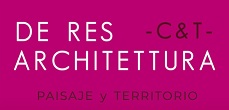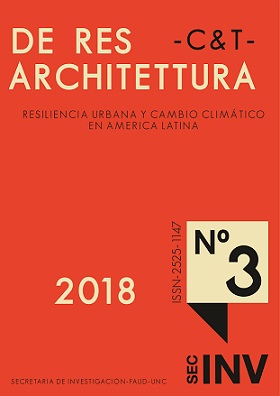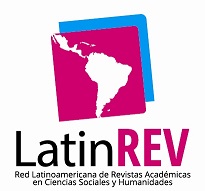Reflexiones sobre resiliencia urbana ante el cambio climático: el caso de la gobernanza local del sector transporte, Santiago de Chile.
Resumen
El presente artículo aborda la problemática del transporte urbano como un factor que no solo contribuye con el aumento de las concentraciones de gases de efecto invernadero (GEI) en la atmósfera, sino que también resulta en serios problemas de salud pública, congestión, contaminación ambiental, entre otros, comprometiendo la resiliencia global del sistema urbano-ambiental. Al relacionar el transporte urbano con el cambio climático y la resiliencia urbana el artículo expone diferentes visiones sobre el rol de la gobernanza a escala local como un aspecto fundamental para mitigar emisiones del sector transporte. El artículo se centra en el caso de Santiago de Chile para explorar las problemáticas urbanas derivadas de políticas de transporte y cómo estas han tenido una repercusión en la estructura y funcionamiento de la ciudad. Finalmente, se discuten una serie de aspectos relevantes para que los gobiernos locales se involucren en actividades de mitigación del cambio climático en el sector transporte. Dichos aspectos son relacionados con el caso de SantiagoReferencias
Adger, WN (2006), 'Vulnerability', Global Environmental Change, 16, Resilience, Vulnerability, and Adaptation: A CrossCutting Theme of the International Human Dimensions Programme on Global Environmental Change, pp. 268-281
Amin, A, & Graham, S (1997), 'The Ordinary City', Transactions of the Institute of British Geographers, 4, p. 411
Bai, X (2007), ‘Integrating global environmental concerns into urban management: the scale and readiness arguments’,
Journal of Industrial Ecology, 11(2), pp. 15-29.
Banister, D (2011), ‘The trilogy of distance, speed and time’, Journal of Transport Geography, 19(4), pp. 950–959.
Barton, JR (2013), ‘Climate change adaptive capacity in Santiago de Chile: Creating a governance regime for
sustainability planning’, International Journal of Urban and Regional Research, 37(6), pp. 1916-1933.
Batterbury, S (2003), 'Environmental Activism and Social Networks: Campaigning for Bicycles and Alternative Transport
in West London', Annals of the American Academy of Political and Social Science, pp. 150-169.
Bin, S, & Dowlatabadi, H (2005), 'Consumer lifestyle approach to US energy use and the related CO2 emissions', Energy
Policy, 33, pp. 197-208.
Bulkeley, H (2010) “Cities and the governing of climate change”, Annual Review of Environment and Resources 35(2),
229–53.
Bulkeley, H, & Betsill, M (2005), 'Rethinking Sustainable Cities: Multilevel Governance and the 'Urban' Politics of Climate
Change', Environmental Politics, 14(1), pp. 42-63
Burch, S 2010, 'Transforming barriers into enablers of action on climate change: Insights from three municipal case
studies in British Columbia, Canada', Global Environmental Change, 20, pp. 287-297
Burch, S (2010), ‘Transforming barriers into enablers of action on climate change: insights from three municipal case
studies in British Columbia, Canada’, Global Environmental Change, 20(2), pp. 287-297.
Corfee-Morlot, J, Cochran, I & Teasdale, PJ (2008), Cities and climate change: harnessing the potential for local action,
in Organization for Economic Co-operation and Development 2008, Competitive Cities and Climate Change OECD,
Milan.
Curtis, C & Low, N (2012), Transport and Mobility: Institutional Barriers to Sustainable Transport, Abingdon, Oxon, GBR:
Ashgate Publishing Group.
De Grange, L., & Troncoso, R. (2011). Impacts of vehicle restrictions on urban transport flows: the case of Santiago,
Chile. Transport Policy, 18(6), 862-869.
Figueroa, C., Hodgson, F., Mullen, C., & Timms, P. (2018). Creating inequality in accessibility: The relationships between
public transport and social housing policy in deprived areas of Santiago de Chile. Journal of Transport Geography,
67, 102-109.
Heinrichs, D, Krellenberg, K, & Fragkias, M (2013), 'Urban Responses to Climate Change: Theories and Governance
Practice in Cities of the Global South', International Journal Of Urban And Regional Research, 37(6), pp. 1865-1878.
Hidalgo, D., & Carrigan, A. (2010). Modernizing public transportation, lessons learned from major bus improvements in
Latin America and Asia. EMBARQ The WRI Center for Sustainable Transport, Washington, DC.
Instituto Nacional de Estadística (INE 2002), Anuario Parque de Vehículos en Circulación 2002, Gobierno de Chile
Instituto Nacional de Estadística (INE 2017a), Anuario Parque de Vehículos en Circulación 2017, Gobierno de Chile
Instituto Nacional de Estadística (INE 2002), Censo Población 2002, Gobierno de Chile
Instituto Nacional de Estadística (INE 2017b), Censo Población 2017, Gobierno de Chile
Intergovernmental Panel on Climate Change (2014), Climate Change 2014: The Physical Science Basis. Contribution of
Working Group I to the Fifth Assessment Report of the Intergovernmental Panel on Climate Change, Cambridge
University Press, Cambridge, UK and New York, NY, USA.
International Energy Agency (IEA 2016), CO2 Emissions from Fuel Combustion, OECD/IEA, París.
Justen, A, Suppa, P, Martínez, F, Kihm, A, Sanhueza, F, (2016), “Escenarios del Sistema de Transporte Urbano y Niveles
de Calidad del Aire”, en Barton, J and Kopfmüller, J (Eds.), Santiago 2030 Escenarios para la Planificación
Estratégica, RIL Editores, Santiago, Chile.
Kamal-Chaoui, L (2008), ‘Competitive cities and climate change: an introductory paper’, Competitive Cities and Climate
Change, OECD conference proceedings Milan, Italy, pp. 29-47.
Kern, K & Alber, G (2008), ‘Governing climate change in cities: modes of urban climate governance in multi-level
systems’, Competitive Cities and Climate Change, OECD conference proceedings Milan, Italy, pp. 171-196.
Koehn, PH (2008), 'Underneath Kyoto: Emerging Subnational Government Initiatives and Incipient Issue-Bundling
Opportunities in China and the United States', Global Environmental Politics, 8(1), pp. 53-77.
Koglin, T (2014), ‘Vélomobility And The Politics Of Transport Planning’, GeoJournal, DOI 10.1007/s10708-014-9565-7,
n.p.
Krellenberg, K., Welz, J., Link, F., & Barth, K. (2017). Urban vulnerability and the contribution of socio-environmental
fragmentation: Theoretical and methodological pathways. Progress in Human Geography, 41(4), 408-431.
Low, N, Gleeson, B, & Rush, E (2005), ‘A multivalent conception of path dependence: the case of transport planning in
metropolitan Melbourne, Australia’, Environmental Sciences, 2(4), pp. 391-408.
Low, N, Gleeson, B, & Rush, E (2003), 'Making Believe: Institutional and Discursive Barriers to Sustainable Transport in
Two Australian Cities', International Planning Studies, 8, 2, pp. 93-114.
Lukas, M., & López-Morales, E. (2018). Real estate production, geographies of mobility and spatial contestation: A twocase study in Santiago de Chile. Journal of Transport Geography, 67, 92-101.
Marsden, G, Ferreira, A, Bache, I, Flinders, M, & Bartle, I (2014), ‘Muddling through with climate change targets: a multilevel governance perspective on the transport sector’, Climate Policy, 14(5), pp. 617-636.
Muñoz, J. C., Batarce, M., & Hidalgo, D. (2014). Transantiago, five years after its launch. Research in Transportation
Economics, 48, 184-193.
Pérez, G., & Sánchez, R. (2010). Convergencia y divergencia en las políticas de transporte y movilidad en América Latina:
ausencia de co-modalismo urbano, Cepal, Edición No 289, número 9
Rizzi, L. I., & De La Maza, C. (2017). The external costs of private versus public road transport in the Metropolitan Area
of Santiago, Chile. Transportation Research Part A: Policy and Practice, 98, 123-140.
Roberts, D (2008), 'Thinking globally, acting locally - institutionalizing climate change at the local government level in
Durban, South Africa', Environment & Urbanization, 20(2), pp. 521-537
Romero-Lankao, P, Qin, H, & Borbor-Cordova, M (2013), 'Exploration of health risks related to air pollution and
temperature in three Latin American cities', Social Science & Medicine, 83, pp. 110-118
Sagaris, L (2010), 'From sustainable transport development to active citizenship and participatory democracy: The
experience of Living City in Chile', Natural Resources Forum, pp. 275-288.
Sagaris, L (2015), 'Lessons from 40 years of planning for cycle-inclusion: Reflections from Santiago, Chile', Natural
Resources Forum, 39(1), pp. 64-81.
Secretaría de Planificación del Transporte (SECTRA 2012), Resultados Encuesta Origen Destino 2012, Ministerio de
Transporte y Telecomunicaciones, Gobierno de Chile.
Sheller, M & Urry, J (2000), ‘The City and the Car’, , vol. 24, no. December 2000, accessed from <http://www3.interscience.wiley.com/journal/119042568/abstract>.
Skinner, D & Rosen, P (2007), ‘Hell in other cyclists: rethinking transport and identity’, in D Horton, P Rosen, & P Cox
(eds), Cycling and Society, Ashgate Publishing Group, Abingdon, Oxon, GBR, pp. 83–96.
Urry, J (2004), ‘The ‘system’ of automobility’, Theory, Culture & Society, 21, pp. 25–39.
Urry, J (2012), ‘Does mobility have a future?’, in M Grieco & J Urry (eds), Mobilities: New Perspectives on Transport and
Society, Ashgate Publishing Group, Farnham, Surrey, GBR, pp. 3–19.
Vicuña del Río, M. (2013). El marco regulatorio en el contexto de la gestión empresarialista y la mercantilización del
desarrollo urbano del Gran Santiago, Chile. Revista Invi, 28(78), 181-219.
Walker, B & Salt, D (2012), Resilience practice: building capacity to absorb disturbance and maintain function,
Washington DC: Island Press.
Woodcock, J, Edwards, P, Tonne, C, Armstrong, B, Ashiru, O, Banister, D, Beevers, S, Chalabi, Z, Chowdhury, Z, Cohen,
A, Franco, O, Haines, A, Hickman, R, Lindsay, G, Mittal, I, Mohan, D, Tiwari, G, Woodward, A, & Roberts, I (2009),
“Series: Public health benefits of strategies to reduce greenhouse-gas emissions: urban land transport”, The
Lancet, 374, pp. 1930-1943.
World Bank (2014), CO2 emissions from transport (% of total fuel combustion) [en línea] Consultado el 20 de agosto de
2018 en https://data.worldbank.org/indicator/EN.CO2.TRAN.ZS?view=chart
Yohe, GW (2001), ‘Mitigative capacity: the mirror image of adaptive capacity on the emissions side’, Climatic Change,
49, pp. 247–262.1
Descargas
Publicado
Número
Sección
Licencia
Usted es libre de:
- Compartir — copiar y redistribuir el material en cualquier medio o formato.
- Adaptar — remezclar, transformar y construir a partir del material.
- para cualquier propósito, incluso comercialmente.








